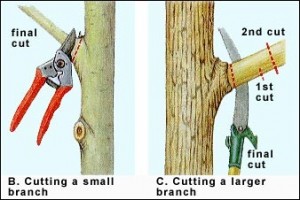
(C) Stockxpert
Strong winds can uproot a tree, snap it in half, blow off limbs or knock small twigs to the ground.
The latter, considered natural pruning, usually is harmless. Uprooting or snapping can be a death sentence for a tree. The loss of a large limb is quite serious, too. It frequently leaves a gaping wound. Even more damaging is when the limb pulls off bark.
When it comes to tree damage we have to take what nature gives us, said Jud Scott, president and owner of Vine and Branch in Carmel, Ind. Scott is a registered consulting arborist.
And, he said, it’s always safety first. Before doing any cleanup work, make sure the limb is not touching a power line. Smaller limbs that have broken from the lower part of a tree may be cleaned up with the proper tools and knowledge of basic pruning techniques. Damage high in a tree usually requires a certified arborist.

Illustration courtesy U.S. Forest Service.
1. From the underside, make a cut about half way through the limb. This notch will prevent the bark from tearing when the limb falls away on the second cut.
2. Make the second cut from the upper side of the branch toward the end of the limb, a few inches away from the first cut. This second cut removes the branch.
3. The final cut removes the stub just beyond the branch collar, which is the slightly swollen area of the limb.
“When the limb tears the bark, the best we can is clean up the broken limb and let the tree recover from its wound,” he said.
For limbs high in a tree or when uncertain about what to do, visit the International Society of Arboriculture’s Web site to find a certified arborist.
Other resources:
- U.S. Forest Service’s How to Prune
- Purdue University’s Storm Damage to Trees and Landscape Plants
[…] Read the rest of this article here http://hoosiergardener.com/?p=1212 […]